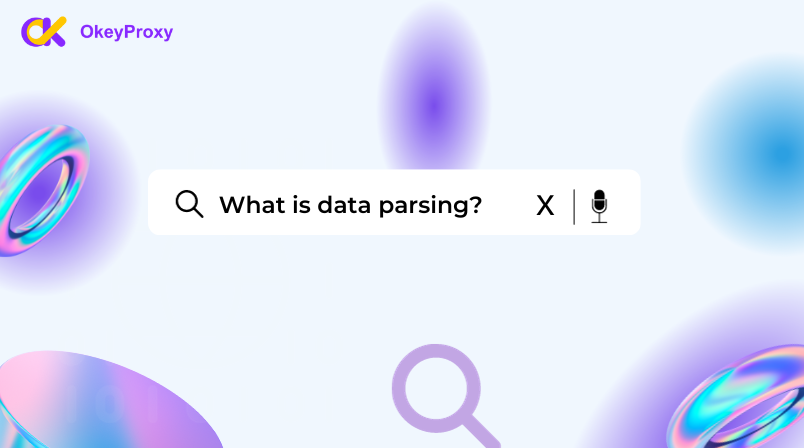Data parsing is the conversion of data from one format to another. It is widely used for structuring data, which is usually done to make existing, unstructured, unreadable data easier to understand.
Data parsing refers to the process of analyzing and extracting relevant information from unstructured or semi-structured data sources. It involves breaking down the data into smaller components, such as fields, records, or attributes, to identify and extract specific data points. This structured information can then be stored, analyzed, and utilized for various purposes.
The Need for Data Parsing
Computers often require translation to communicate effectively. To help machines understand data strings in a current format that they don’t recognize or understand, parsing is used to convert the data into a form that the device can understand and manipulate, which is similar to providing a translation so that people can understand text in another language.
Data parsing is a process that changing unstructured and illegible strings of data into structured and simple collections that computers can easily understand.
Ranging from finance and education to big data and e-commerce. data analysis is widely used in different industries today. An effective data parser can extract relevant information from raw data without any manual intervention. The parsed data can be used for a variety of activities, including market research, price comparisons, etc. The technology enables companies to make informed decisions and obtain a competitive advantage. Additionally, data analysis improves work efficiency and reduces costs by automating tedious tasks, thereby saving time and manpower. In today’s fierce market competition, data analysis has become a key factor in corporate achievement.
Use Cases of Data Parsing
1. Web Scraping: Data parsing is widely used in web scraping, which unstructured data from websites is extracted and transformed into well-structured information. By parsing web pages, businesses can gather valuable data to identify trends in the market, know about consumers’ behavior, and see how the competitive landscape is changing.
2. Document Processing: Many industries deal with large volumes of unstructured documents, like invoices, contracts, or resumes. Data parsing allows organizations to extract relevant information from these documents and convert them into structured data so that they can manage and analyze easier.
3. Data Integration: It is essential in integrating data from multiple sources, such as databases, spreadsheets, or APIs. By parsing data into a standardized format, companies can merge and consolidate data from various systems, enabling a comprehensive perspective of their operations.
4. Natural Language Processing: It is reported that data parsing is a fundamental component of natural language processing (NLP) techniques. Throughout parsing sentences or paragraphs, NLP algorithms can extract meaningful information, such as entities, relationships, or sentiments. It makes applications like chatbots, sentiment analysis, language translation, etc. into reality.
Importance of Data Parsing
1. Improved Data Quality: Data parsing helps improve data quality by organizing and standardizing information. Using extracting specific data points, such as names, addresses, or dates, data parsing ensures consistency and accuracy in the stored data. This leads to better data integrity and reliability for decision-making processes.
2. Efficient Data Analysis: Parsing data into a structured format enables efficient data analysis. By organizing data into relevant fields or attributes, analysts can easily filter, sort, and search for specific information. This facilitates quicker and more accurate data analysis, allowing businesses to gain valuable insights and make informed decisions.
3. Automation and Integration: Data parsing plays a crucial role in automating processes and integrating data from different sources. By parsing data into a structured format, it becomes easier to transfer, merge, or integrate data across various systems or databases. This seamless integration enhances workflow efficiency and reduces manual data entry errors.
Downsides of data parsing
When parsing the data, you usually cope with inputs that could be raw, unstructured, or semi-structured. These inputs might originate from diverse data sources like sensors, log files, databases, or web pages. Since the data source could be different, the format and quality of the data can vary from each other too. However, even after cleaning and transforming, the input data could still have inaccuracies, errors, and inconsistencies.
In order to process multiple input documents at the same time and save time, you may want to employ methods to parallelize data processing. However, this approach may increase resource usage and overall complexity. Therefore, to effectively parse big data, advanced tools, and techniques must be used.
Conclusion
Data parsing is a vital process for extracting structured information from unstructured or semi-structured data sources. By parsing data, businesses can improve data quality, enhance data analysis, and automate processes. The applications of data parsing span across industries, including web scraping, document processing, data integration, and natural language processing. And OkeyProxy is believed a reliable provider for users to assist with web scraping tasks. Applying data parsing techniques empowers organizations to unlock the power of structured information, enabling informed decision-making, improved efficiency, and a competitive edge in the data-driven world.


